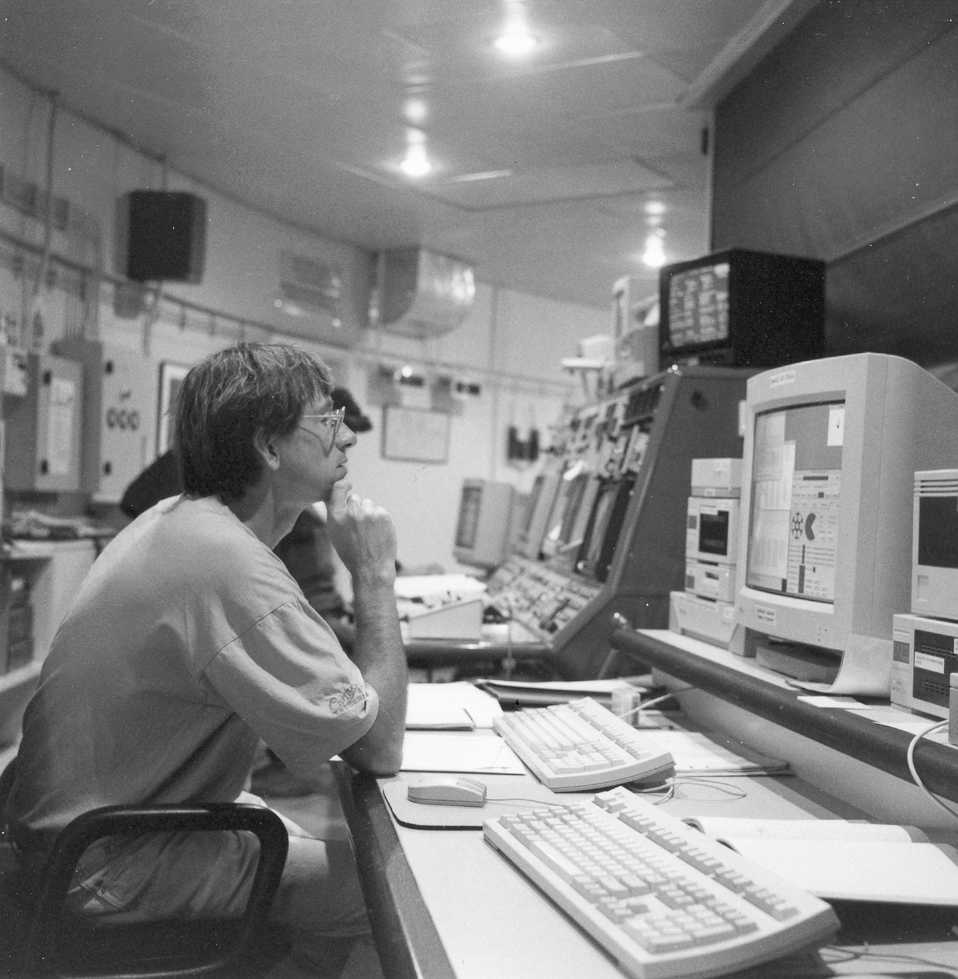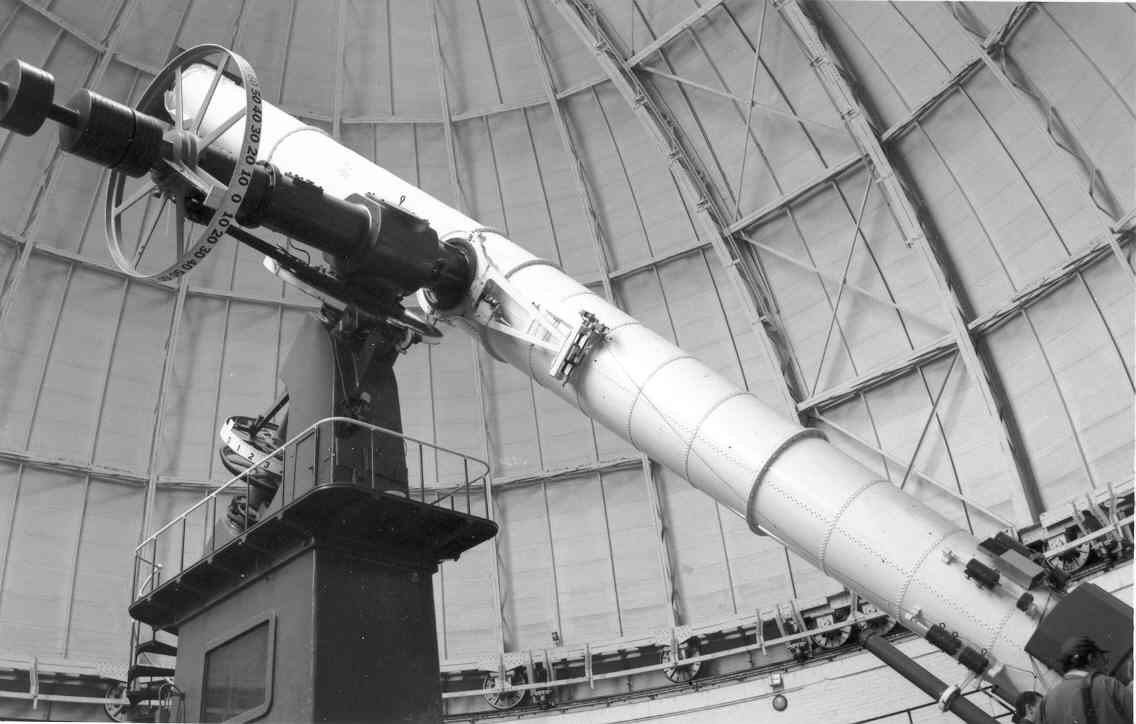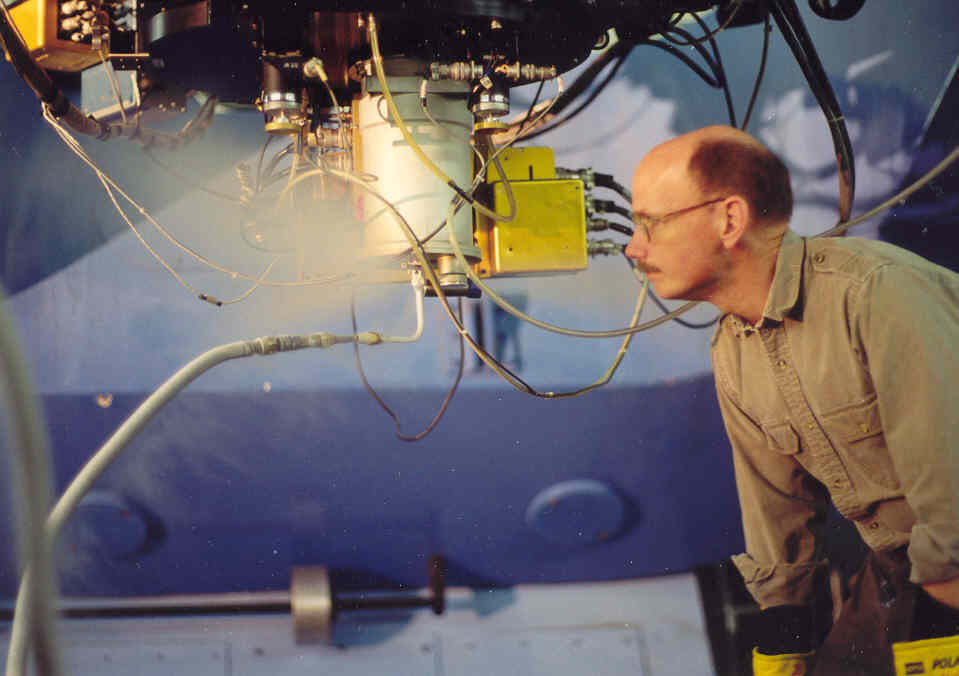Doing Astronomy
 Left, a picture of astronomy in action. The astronomer is comparing his calculation (with an
old-fashioned analog computer) to the sky, thereby acting both as theorist and observer.
Nowadays the computer would be digital and the observation would be electronic; in fact
they might be carried out by entirely different people. The process, however, is
the same.
Left, a picture of astronomy in action. The astronomer is comparing his calculation (with an
old-fashioned analog computer) to the sky, thereby acting both as theorist and observer.
Nowadays the computer would be digital and the observation would be electronic; in fact
they might be carried out by entirely different people. The process, however, is
the same.
A Roman seal-ring from the first century BC/AD. Image © the Syndics
of the Fitzwilliam Museum, Cambridge; all rights reserved. Reproduction
by permission.
Why?
Astronomy has had practical applications. I myself have used a sextant to navigate at sea,
relying on computations of planetary motion performed by the U. S. Naval Observatory.
With the advent of various satellite navigation systems (especially GPS), though,
that sort of technique is pretty much obsolete.
One could make a case that astronomy has provided the motivation for many advances in
science and technology. Geometry and trigonometry, for instance, were in part developed
to calculate the size and shape of the universe, as well as the motions of the planets
(under the Ptolemaic system). Newtonian mechanics, including the law of gravity, came
about the better to explain celestial motions, and calculus was developed to calculate them.
Quantum mechanics was necessary to understand stellar spectra, and nuclear physics to
explain how stars shine. Special and general relativity find few applications on Earth,
though they are routinely used in astronomical contexts. And so forth.
Too much should not be made of this. Astronomy has always been the occupation of a very small
proportion of people, and the regular concern of not many more. It is not a way to get rich or
famous. The overwhelming, and best, motivation to study astronomy is because you want to.
You find it interesting, or inspiring. You are moved by the brilliance of the stars at night,
or the beauty of a difficult equation which matches the data. The sudden insight which makes
the pulsation of a star real to you, finally matching your theory to
the tiny ripples of the microwave background, or possibly
the first picture from a new infrared imager you've designed and built: these are reasons to
do astronomy.
Who?
Not all astronomers are professional; in fact, amateur astronomers outnumber
us, and contribute a great deal to the science. For instance, there are
thousands of comparatively bright variable stars in the sky. Professionals
are simply too few to monitor all of them, or even just those in which they
specialize. So amateurs, on their own time and with their own equipment,
watch these stars. Their efforts are coordinated by organizations like the
American Association of Variable Star Observers,
whose Web site is highly recommended.
Professional astronomers, nowadays, follow an identifiable career path. As
undergraduates they may study physics or mathematics, or perhaps another of
the related sciences, since there are few universities with an astronomy
major at that level. Graduate school, almost always ending in an astronomy doctorate,
is followed by one or more ``postdocs,'' temporary jobs (one to five years) nominally
concentrating on research. Most of us are looking for some job security
eventually, in the form of an academic job (some mixture of research and teaching)
or something on the staff of an observatory (like CTIO) or a similar institution.
Even though it remains the nominal goal of higher education in the subject,
most people with a doctorate in astronomy do not end up with a full-time academic
job in the discipline.
Astronomers are thin on the ground. With few in any one place, we tend to come from
all over, and go to many places. We must be prepared to travel. When your postdoc
in Wisconsin ends, there may not be anything opening up in your field in the same part
of the country, or even the same country. I went from graduate school at Cambridge,
England, to a teaching position at Annapolis, Maryland, to an observatory post at La
Serena, Chile: three jobs, three countries, three continents.
Astronomy is international. One of my collaborators on a project is English; the other
was born in Hong Kong and now works for the European Southern Observatory in Chile and
Germany. A conversation I overheard in the cafeteria of one of the observatories
started in English, moved into Spanish without a pause, then French, German, Spanish
again, and ended in English. (If you're going to become an observer, Spanish is a
particularly good language to learn.)
What?
Astronomers are famous for sorting things into classes. It's said that, faced with two
objects, an astronomer will define three classes, I, II, and Ib, with the option of
Ic and III depending on more observations. Astronomers divide themselves into
theorists and observers, with some defining numerical simulation as a third class
(I lump them with theorists), and others breaking out instrument-builders separately.
(Some hold them to be, instead, a type of engineer. I don't entirely agree.)
I started out as a theorist, but found myself unexpectedly with an observing
program on my hands. Now I work about evenly on both sides. (I have not designed
an instrument. Yet.)
 Observers concentrate on collecting data at a telescope, then publishing it in some
usable form for theorists to explain. The telescope may collect radio waves, gamma rays or
visible light; observational techniques vary greatly, so an astronomer may be identified
(for example) as a mid-infrared observer.
Observers concentrate on collecting data at a telescope, then publishing it in some
usable form for theorists to explain. The telescope may collect radio waves, gamma rays or
visible light; observational techniques vary greatly, so an astronomer may be identified
(for example) as a mid-infrared observer.
Looking through the eyepiece of a telescope is almost exclusively reserved for amateurs
nowadays. Our data are collected in electronic images (using more refined, and much more
expensive, versions of the detectors in digital cameras, kept cool using liquid
nitrogen). So an astronomer will be found
during an observing run in the well-lighted control room of a telescope building, kept well
away from the telescope itself (human body heat would disturb the air, causing poor images),
examining data on the screen of a computer terminal. (I like to go outside and look at the
stars also.)

But observers cannot ignore theory altogether. In order to get time on a telescope, they must
convince the time-assignment committee (TAC) that the project they have in mind will answer
some important question in astronomy; big telescopes are too expensive to build and operate to
allow someone to just look around to see what pops up.
 For example: in our search for undiscovered Local Group dwarf galaxies, I went through available
data systematically, coming up with a list of objects that might possibly be what we sought.
I then calculated how big a telescope I would need, and what kind of observations to do, in
order to check each one. Then I put together an observing proposal, explaining why it was
important to find this kind of galaxy, and showing my calculations. I was awarded five nights
on the CTIO 1.5m, to start off with. (I have submitted other observing proposals which did
not get time. Telescopes normally get between two and five times as many observing proposals
as they can handle. It's pretty competitive.)
For example: in our search for undiscovered Local Group dwarf galaxies, I went through available
data systematically, coming up with a list of objects that might possibly be what we sought.
I then calculated how big a telescope I would need, and what kind of observations to do, in
order to check each one. Then I put together an observing proposal, explaining why it was
important to find this kind of galaxy, and showing my calculations. I was awarded five nights
on the CTIO 1.5m, to start off with. (I have submitted other observing proposals which did
not get time. Telescopes normally get between two and five times as many observing proposals
as they can handle. It's pretty competitive.)
Theorists, of course, differ in detail just like observers do. As a general summary,
I can say that it is their task to find a (mathematical) model which fits the data. This could
be by putting together a series of computer simulations with various assumptions, and choosing
the one which best fits observations. Or one could find, as I did in
a recent paper, that nothing seems to fit, so something must be missing. Sometimes everything
works (well enough), and the result is a number: the age of the Universe, say.
Or perhaps a theorist runs his calculation, and finds that there have been no observations of
the proper kind with which to compare his results. He passes this on to an observer, possibly
by publishing a paper, alternatively by setting up a collaboration with him. Then suppose the
observer finds that there is no combination of telescope and instrument which can possibly
make the necessary observation. This information is passed to an instrumentalist
(a clumsy word, but I can't think of a better at the moment), who comes up with a design to
do it.
Of course, in real life, it's a much messier process, with thousands of papers published yearly
on all aspects from basic theory to the performance of a particular detector, information and
speculation flowing several ways, some of it mistaken, and now and then statistics
miscalculated or misused. That only proves that astronomers are people.
Return to:
ASR group home page
Dr. Whiting's home page
last updated 5 December 2005
 Left, a picture of astronomy in action. The astronomer is comparing his calculation (with an
old-fashioned analog computer) to the sky, thereby acting both as theorist and observer.
Nowadays the computer would be digital and the observation would be electronic; in fact
they might be carried out by entirely different people. The process, however, is
the same.
Left, a picture of astronomy in action. The astronomer is comparing his calculation (with an
old-fashioned analog computer) to the sky, thereby acting both as theorist and observer.
Nowadays the computer would be digital and the observation would be electronic; in fact
they might be carried out by entirely different people. The process, however, is
the same. 

